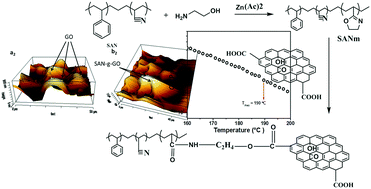当前位置:
X-MOL 学术
›
Phys. Chem. Chem. Phys.
›
论文详情
Our official English website, www.x-mol.net, welcomes your
feedback! (Note: you will need to create a separate account there.)
Phase miscibility and dynamic heterogeneity in PMMA/SAN blends through solvent free reactive grafting of SAN on graphene oxide
Physical Chemistry Chemical Physics ( IF 2.9 ) Pub Date : 2018-07-04 00:00:00 , DOI: 10.1039/c8cp02716a Tanyaradzwa S. Muzata 1, 2, 3, 4 , Jagadeshvaran P. L. 1, 2, 3, 4 , Goutam Prasanna Kar 1, 2, 3, 4 , Suryasarathi Bose 1, 2, 3, 4
Physical Chemistry Chemical Physics ( IF 2.9 ) Pub Date : 2018-07-04 00:00:00 , DOI: 10.1039/c8cp02716a Tanyaradzwa S. Muzata 1, 2, 3, 4 , Jagadeshvaran P. L. 1, 2, 3, 4 , Goutam Prasanna Kar 1, 2, 3, 4 , Suryasarathi Bose 1, 2, 3, 4
Affiliation

|
The spatial distribution of nanoparticles in a particular host polymer matrix can be improved by using brush coated nanoparticles. In this work we have grafted styrene-acrylonitrile (SAN) onto the surface of graphene oxide (GO) and investigated as to how the demixing temperature, morphology and volume cooperativity of PMMA/SAN blends are influenced. Grafting of polymer chains on the surface of nanoparticles usually involves the use of large amounts of solvents, many which are detrimental to the environment besides involving cumbersome processes. SAN-g-GO was prepared by a robust solvent-free strategy wherein the cyano group in SAN was replaced by oxazoline groups during melt mixing in the presence of zinc acetate and ethanol amine. These newly created oxazoline groups reacted with the COOH group of GO under melt extrusion resulting in grafting of SAN on the surface of GO sheets. The effect of SAN-g-GO nanoparticles on the demixing, local segmental motions and morphology evolution for different annealing times was carefully investigated in a classical LCST system, PMMA/SAN blend, using melt rheology, modulated DSC and AFM, respectively. The changes in viscoelastic behavior in the vicinity of demixing are investigated systematically for the control, and blends with GO and SAN-g-GO. Various models were used to gain insight into the spinodal decomposition temperatures of the blends. Interestingly, the demixing temperature determined rheologically and the spinodal decomposition temperature increased significantly in the presence of polymer grafted nanoparticles in comparison to the control and blends with GO. The evolution of the morphology, interfacial driven coarsening as a function of temperature and the localization of nanoparticles were assessed using atomic force microscopy. The cooperatively re-arranging regions estimated from calorimetric measurements begin to suggest enhanced dynamic heterogeneity in the presence of GO and SAN-g-GO in the blends. Taken together, our study reveals that the solvent-free approach of grafting SAN onto GO delays demixing, suppresses coalescence and alters cooperative relaxation in PMMA/SAN blends.
中文翻译:

通过在石墨烯氧化物上无溶剂反应性接枝SAN,PMMA / SAN混合物中的相混溶性和动态异质性
通过使用刷涂的纳米颗粒,可以改善特定主体聚合物基质中纳米颗粒的空间分布。在这项工作中,我们将苯乙烯-丙烯腈(SAN)接枝到了氧化石墨烯(GO)的表面上,并研究了如何影响PMMA / SAN混合物的分离温度,形态和体积协同作用。在纳米颗粒表面上接枝聚合物链通常涉及使用大量溶剂,其中许多溶剂除了涉及繁琐的过程外,还对环境有害。SAN的g ^通过牢固的无溶剂策略制备-GO,其中在乙酸锌和乙醇胺存在下的熔融混合过程中,SAN中的氰基被恶唑啉基取代。这些新产生的恶唑啉基团在熔融挤出下与GO的COOH基团反应,导致SAN在GO片材的表面上接枝。在经典的LCST系统PMMA / SAN共混物中,分别使用熔体流变学,调制DSC和AFM仔细研究了SAN- g -GO纳米颗粒对不同退火时间的分解,局部节段运动和形态演变的影响。为了控制,系统地研究了混合附近的粘弹性行为的变化,并与GO和SAN- g共混-走。使用各种模型来了解混合物的旋节线分解温度。有趣的是,与对照以及与GO共混的情况相比,在存在聚合物接枝的纳米颗粒的情况下,流变学确定的混合温度和旋节线分解温度显着增加。使用原子力显微镜评估了形态的演变,界面驱动的粗化随温度的变化以及纳米颗粒的定位。通过量热法估计的合作重新排列区域开始表明,在存在GO和SAN- g的情况下,动态异质性增强了-GO在混合中。两者合计,我们的研究表明,将SAN接枝到GO上的无溶剂方法可延迟脱胶,抑制聚结并改变PMMA / SAN共混物中的协同松弛。
更新日期:2018-07-04
中文翻译:

通过在石墨烯氧化物上无溶剂反应性接枝SAN,PMMA / SAN混合物中的相混溶性和动态异质性
通过使用刷涂的纳米颗粒,可以改善特定主体聚合物基质中纳米颗粒的空间分布。在这项工作中,我们将苯乙烯-丙烯腈(SAN)接枝到了氧化石墨烯(GO)的表面上,并研究了如何影响PMMA / SAN混合物的分离温度,形态和体积协同作用。在纳米颗粒表面上接枝聚合物链通常涉及使用大量溶剂,其中许多溶剂除了涉及繁琐的过程外,还对环境有害。SAN的g ^通过牢固的无溶剂策略制备-GO,其中在乙酸锌和乙醇胺存在下的熔融混合过程中,SAN中的氰基被恶唑啉基取代。这些新产生的恶唑啉基团在熔融挤出下与GO的COOH基团反应,导致SAN在GO片材的表面上接枝。在经典的LCST系统PMMA / SAN共混物中,分别使用熔体流变学,调制DSC和AFM仔细研究了SAN- g -GO纳米颗粒对不同退火时间的分解,局部节段运动和形态演变的影响。为了控制,系统地研究了混合附近的粘弹性行为的变化,并与GO和SAN- g共混-走。使用各种模型来了解混合物的旋节线分解温度。有趣的是,与对照以及与GO共混的情况相比,在存在聚合物接枝的纳米颗粒的情况下,流变学确定的混合温度和旋节线分解温度显着增加。使用原子力显微镜评估了形态的演变,界面驱动的粗化随温度的变化以及纳米颗粒的定位。通过量热法估计的合作重新排列区域开始表明,在存在GO和SAN- g的情况下,动态异质性增强了-GO在混合中。两者合计,我们的研究表明,将SAN接枝到GO上的无溶剂方法可延迟脱胶,抑制聚结并改变PMMA / SAN共混物中的协同松弛。











































 京公网安备 11010802027423号
京公网安备 11010802027423号